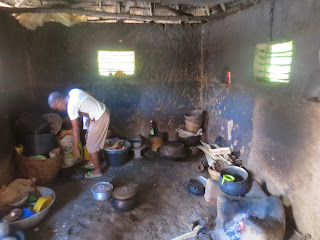

We walked down a path with the engineer who installed the generator and went to a couple of villages which are occupied today. The homes were with thatched roofs, some with concrete and block walls and some with mud walls. We met a Canadian student on a break from school for about three months who was living in one of the villages with a sponsor family. She invited us into the buildings the family occupies, a kitchen, a living room building, and a bedroom building. No amenities there. It had a dirt floor which she had covered with wall paper, a mattress with no springs and a mosquito net. The kitchen had a small ember fire burning in a fireplace made from a rock with a pantry tightly sealed with screen. It looked like the place the Disney folks used as the basis for some of their African villages in their theme parks, but it was real.


The families apparently live off of what they can grow and their fishing and oyster business. The ground was littered with, almost carpeted with oyster shells. On the mainland from where we caught the boat there were huge stacks, probably four feet high, of oyster shells and large mats with drying oysters on it. People gathered around shucking the oysters in groups.




Another treat, as we arrived there was a siren blaring and a group of people at the end of the street. As they got closer it was a funeral procession. The casket was being carried by six men with women dancing and singing in the front. Behind the casket was a brass band with several drums. The siren was from the town ambulance which was behind the procession. We understand that funerals are major events and last up to three days.

All in all, it was a wonderful experience even it was four hours of driving on pocked roads with heavy traffic. Deanne got to dance with the children. We marked it on the map so we can go back and see it again however we doubt any second trip would include the funeral or the invitation to see the inside of the home.


Thanks for the update! I remember reading about that project to generate electricity! That's so fun you could see it and share these things with us!
ReplyDeletexoxox Betty Whiting
What great adventures you're having!! Isn't it amazing to see what simple circumstances people can live in? It seems there should be something they could do with all those oyster shells. Keep up the good work and the interesting posts!
ReplyDelete